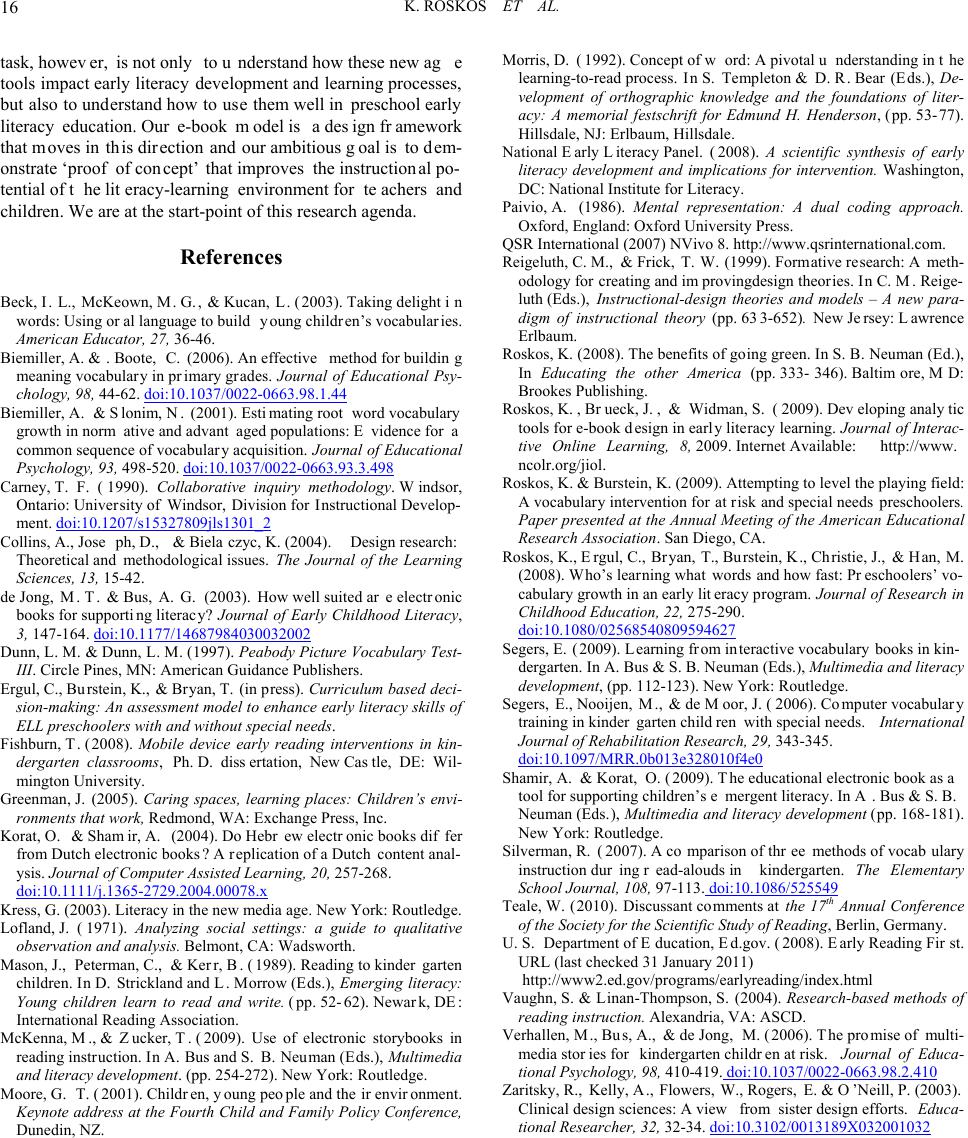
K. ROSKOS ET AL.
16
task, however, is not only to understand how these new age
tools impact early literacy development and learning processes,
but also to understand how to use them well in preschool early
literacy education. Our e-book model is a design framework
that moves in this direction and our ambitious goal is to dem-
onstrate ‘proof of concept’ that improves the instructional po-
tential of t he literacy-learning environment for teachers and
children. We are at the start-point of this research agenda.
References
Beck, I. L., McKeown, M. G., & Kucan, L. (2003). Taking delight in
words: Using oral language to build young children’s vocabularies.
American Educator, 27, 36-46.
Biemiller, A. &. Boote, C. (2006). An effective method for building
meaning vocabulary in primary grades. Journal of Educational Psy-
chology, 98, 44-62. doi:10.1037/0022-0663.98.1.44
Biemiller, A. & Slonim, N. (2001). Estimating root word vocabulary
growth in normative and advant aged populations: E vidence for a
common sequence of vocabulary acquisition. Journal of Educational
Psychology, 93, 498-520. doi:10.1037/0022-0663.93.3.498
Carney, T. F. (1990). Collaborative inquiry methodology. Windsor,
Ontario: University of Windsor, Division for Instructional Develop-
ment. doi:10.1207/s15327809jls1301_2
Collins, A., Joseph, D., & Bielaczyc, K. (2004). Design research:
Theoretical and methodological issues. The Journal of the Learning
Sciences, 13, 15-42.
de Jong, M. T. & Bus, A. G. (2003). How well suited ar e electronic
books for supporting literacy? Journal of Early Childhood Literacy,
3, 147-164. doi:10.1177/14687984030032002
Dunn, L. M. & Dunn, L. M. (1997). Peabody Picture Vocabulary Test-
III. Circle Pines, MN: American Guidance Publishers.
Ergul, C., Burstein, K., & Bryan, T. (in press). Curriculum based deci-
sion-making: An assessment model to enhance early literacy skills of
ELL preschoolers with and without special needs.
Fishburn, T. (2008). Mobile device early reading interventions in kin-
dergarten classrooms, Ph. D. dissertation, New Castle, DE: Wil-
mington University.
Greenman, J. (2005). Caring spaces, learning places: Children’s envi-
ronments that work, Redmond, WA: Exchange Press, Inc.
Korat, O. & Shamir, A. (2004). Do Hebrew electronic books differ
from Dutch electronic books? A replication of a Dutch content anal-
ysis. Journal of Computer Assisted Learning, 20, 257-268.
doi:10.1111/j.1365-2729.2004.00078.x
Kress, G. (2003). Literacy in the new media age. New York: Routledge.
Lofland, J. (1971). Analyzing social settings: a guide to qualitative
observation and analysis. Belmont, CA: Wadsworth.
Mason, J., Peterman, C., & Kerr, B. (1989). Reading to kinder garten
children. In D. Strickland and L. Morrow (Eds.), Emerging literacy:
Young children learn to read and write. (pp. 52-62). Newark, DE:
International Reading Association.
McKenna, M., & Zucker, T. (2009). Use of electronic storybooks in
reading instruction. In A. Bus and S. B. Neuman (Eds.), Multimedia
and literacy developm ent. (pp. 254-272). New York: Routledge.
Moore, G. T. (2001). Children, young people and their environment.
Keynote address at the Fourth Child and Family Policy Conference,
Dunedin, NZ.
Morris, D. (1992). Concept of word: A pivotal understanding in the
learning-to-read process. In S. Templeton & D. R. Bear (Eds.), De-
velopment of orthographic knowledge and the foundations of liter-
acy: A memorial festschrift for Edmund H. Henderson, (pp. 53-77).
Hillsdale, NJ: Erlbaum, Hillsdale.
National Early Literacy Panel. (2008). A scientific synthesis of early
literacy development and implications for intervention. Washington,
DC: National Institute for Literacy.
Paivio, A. (1986). Mental representation: A dual coding approach.
Oxford, England: Oxford University Press.
QSR International (2007) NVivo 8. http://www.qsrinternational.com.
Reigeluth, C. M., & Frick, T. W. (1999). Formative research: A meth-
odology for creating and improvingdesign theories. In C. M. Reige-
luth (Eds.), Instructional-design theories and models – A new para-
digm of instructional theory (pp. 633-652). New Jersey: Lawrence
Erlbaum.
Roskos, K. (2008). The benefits of going green. In S. B. Neuman (Ed.),
In Educating the other America (pp. 333-346). Baltimore, MD:
Brookes Publishing.
Roskos, K., Brueck, J., & Widman, S. (2009). Developing analytic
tools for e-book design in early literacy learning. Journal of Interac-
tive Online Learning, 8, 2009. Internet Available: http://www.
ncolr.org/jiol.
Roskos, K. & Burstein, K. (2009). Attempting to level the playing field:
A vocabulary intervention for at risk and special needs preschoolers.
Paper presented at the Annual Meeting of the American Educational
Research Association. San Diego, CA.
Roskos, K., Ergul, C., Bryan, T., Burstein, K., Christie, J., & Han, M.
(2008). Who’s learning what words and how fast: Preschoolers’ vo-
cabulary growth in an early literacy program. Journal of Research in
Childhood Education, 22, 275-290.
doi:10.1080/02568540809594627
Segers, E. (2009). Learning from interactive vocabulary books in kin-
dergarten. In A. Bus & S. B. Neuman (Eds.), Multimedia and literacy
development, (pp. 112-123). New York: Routledge.
Segers, E., Nooijen, M., & de Moor, J. (2006). Computer vocabulary
training in kinder garten children with special needs. International
Journal of Rehabilitatio n Research, 29, 343-345.
doi:10.1097/MRR.0b013e328010f4e0
Shamir, A. & Korat, O. (2009). The educational electronic book as a
tool for supporting children’s emergent literacy. In A . Bus & S. B.
Neuman (Eds.), Multimedia and literacy development (pp. 168-181).
New York: Routledge.
Silverman, R. (2007). A comparison of three methods of vocabulary
instruction during read-alouds in kindergarten. The Elementary
School Journal, 108, 97-113. doi:10.1086/525549
Teale, W. (2010). Discussant comments at the 17th Annual Conference
of the Society for the Scientific Study of Reading, Berlin, Germany.
U. S. Department of Education, Ed.gov. (2008). Early Reading First.
URL (last checked 31 January 2011)
http://www2.ed.gov/programs/earlyreading/index.html
Vaughn, S. & Linan-Thompson, S. (2004). Research-based methods of
reading instruction. Alexandria, VA: ASCD.
Verhallen, M., Bus, A., & de Jong, M. (2006). The promise of multi-
media stories for kindergarten children at risk. Journal of Educa-
tional Psychology, 98, 410-419. doi:10.1037/0022-0663.98.2.410
Zaritsky, R., Kelly, A., Flowers, W., Rogers, E. & O’Neill, P. (2003).
Clinical design sciences: A view from sister design efforts. Educa-
tional Researcher, 32, 32-34. doi:10.3102/0013189X032001032